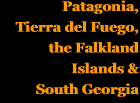Operating the line to Esquel
Traffic
Livestock and wool were the mainstays of the goods traffic for many years, but timber, and all sorts of merchandise featured strongly, for initially there was no other way of reaching the estancias and villages along the route.
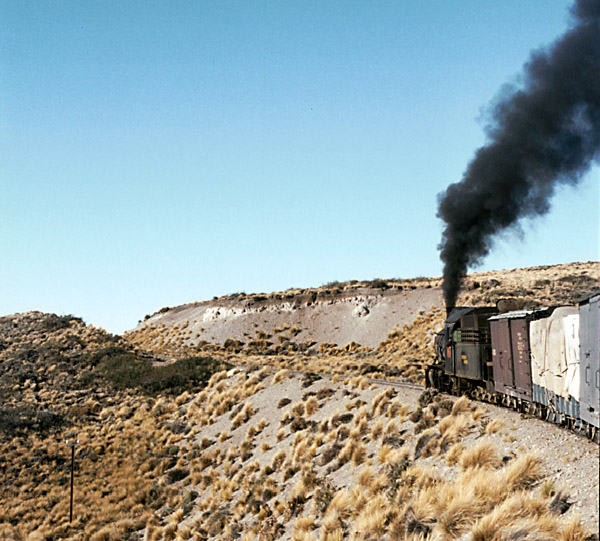
Timetables
Sections of the route were opened from 1936 onwards. The first available working timetable is that for January 1946. At that date the railway was running full as far as El Maiten, whilst goods trains were running further and were carrying passengers semi-officially as far as Lepa. At that time there was a daily train from Ing. Jacobacci to El Maiten, running as a mixed on Wednesdays and Sundays and as a goods train on other days. It took between ten and twelve hours for the journey. There was also a thrice-weekly afternoon goods train which ran as far as Rio Chico, continuing to El Maiten the next morning. The same system worked in reverse, so that overnight on Tuesdays, Thursdays and Sundays, there would have been two trains spending the night at Rio Chico before continuing in each direction. It may be that crews, or indeed locos, were exchanged here. Onwards from El Maiten, twice a week on Tuesdays and Fridays there was a goods train to Lepa, returning the same afternoon, whilst on Mondays and Thursdays the train ran right through to Esquel, returning two days later. These trains to Esquel may well have largely been carrying materials to complete the construction of the line.
The 1956 passenger timetable is set out in the table below. It can be summarised as one through train each way per day, taking 13 or 14 hours. Obviously there will have been goods trains not shown here.
INGENIERO JACOBACCI - ESQUEL (Cuadro 25)
|
Km.
|
SALIDAS
|
43B Mixto
Conduce coche Restaurante hasta Fitalancao
|
REGRESOS
|
44B Mixto
Conduce coche Restaurante desde Fitalancao
|
 |
P. Constitución .. sal.
(Véase Cuadro 23)
|
Lu. Mi. y Vi.
17.05
|
Esquel ...... sal.
|
Lu. Mi. y Vi.
6.35
|
 |
Ing. Jacobacci ... llg.
|
Do. Mi. y Vi
6.15
|
K. 399 (Des. Los Cuarteles)
|
 |
 |
Ing. Jacobacci ... sal.
|
8.35
|
K. 383 (Des. Nahuel Pan)
|
7.23
|
1562
|
Emp. S. C. de Bariloche
|
9.04F
|
K. 353 (Des. La Cancha)
|
8.26
|
1590
|
Des. Ojos de Agua
|
10.07
|
K. 334 (Des. Mayoco) (Ap.)
|
9.0?F
|
160?
|
Des. Futa Ruin
|
11.39F
|
Km. 310 (Lepá) .. llg.
|
9.52
|
1631
|
Des. M. Choique
|
11.20
|
Km. 310 (Lepá) .. sal.
|
9.57
|
1654
|
Des. A. Troncoso
|
12.0?F
|
Km. 287 (Leleque)
|
10.38
|
1674
|
Cerro Mesa
|
13.03
|
ng. Bruno J. Thomae
|
11.16F
|
1721
|
Des. Fitalancao
|
14.45
|
El Maiten ..... llg.
|
12.00
|
1748
|
Ñorquincó
|
15.45
|
El Maiten ..... sal.
|
12.15
|
1784
|
El Maiten ..... llg.
|
16.45
|
Ñorquincó
|
13.22
|
 |
El Maiten ..... sal.
|
17.00
|
Des. Fitalancao
|
14.40
|
1810
|
Ing. Bruno J. Thomae
|
17.50F
|
Cerro Mesa
|
16.30
|
1834
|
Km. 287 (Leleque)
|
18.30
|
Des. A. Troncoso
|
17.10F
|
1857
|
Km. 310 (Lepá) .. llg.
|
19.13
|
Des. M. Choique
|
18.05
|
 |
Km. 310 (Lepá) .. sal.
|
19.22
|
Des. Futa Ruin
|
18.43F
|
1881
|
K. 334 (Des. Mayoco) (Ap.)
|
20.15F
|
Des. Ojos de Agua
|
19.19
|
1901
|
K. 353 (Des. La Cancha)
|
20.58
|
Emp. S. C. de Bariloche
|
20.07F
|
1930
|
K. 383 (Des. Nahuel Pan)
|
21.57
|
Ing. Jacobacci ... llg.
|
20.35
|
1947
|
K. 399 (Des. Los Cuarteles)
|
 |
Ing. Jacobacci ... sal.
(Véase Cuadro 23)
|
22.45
|
1949
|
Esquel ...... llg.
|
22.35
|
P. Constitución .. llg.
|
Mi.Vi.y Do.
10.49
|
Los pasajeros trasbordarán en Ingeniero Jacobacci. F Parada facultativa para subir o bajar pasajeros.
|
Accidents
Weather conditions can be very severe in a Patagonian winter. Snow ploughs are needed regularly, and wind can not only delay trains but can even cause derailments. Accidents of this nature were recorded near Norquinco in August 1959, near Lepá in October 1960, and near Fitalancuo in May 1967. This last was more serious - the dining car caught fire! (1)
The picture below, kindly provided by Señor Diego de Bunder of Puerto Madryn from his grandfather's collection, shows a different sort of derailment, possibly caused by collision with the cow whose carcase appears to be next to the people in the background. This was probably near Cerro Mesa, and most likely after the Second World War though the loco is still running on coal. The photo shows a number of features not seen in other pictures: there are two wagons of large timber. The loco tender bears coal retaining boards to increase the capacity, and also a full-sized electric headlamp for running in reverse. This raises the issue of whether Cerro Mesa had a turning triangle or not. Cerro Mesa was for many years a loco changing point but the itinerary of the line mentions no turning arrangement. If such a facility was not available, then clearly the locos would have needed a headlamp for running in reverese if not also a cow-catcher/pilot.
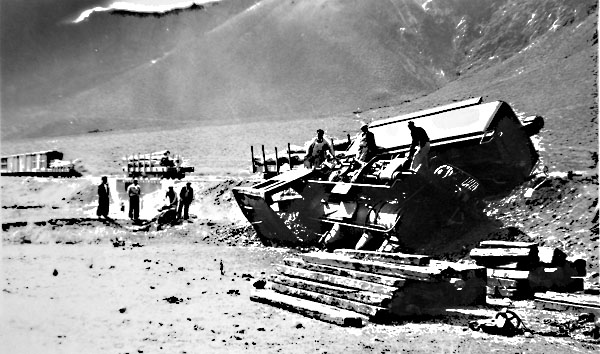
The next picture shows a spectacular pile-up in the cutting just north of the Cerro Mesa bridge. Nothing is known about this incident except that it probably happened fairly early on in FC General Roca times, judging by the bright new lettering. At a guess, this was a run away, for the jack-knifing of so many wagons implies a good deal of kinetic energy being expended.
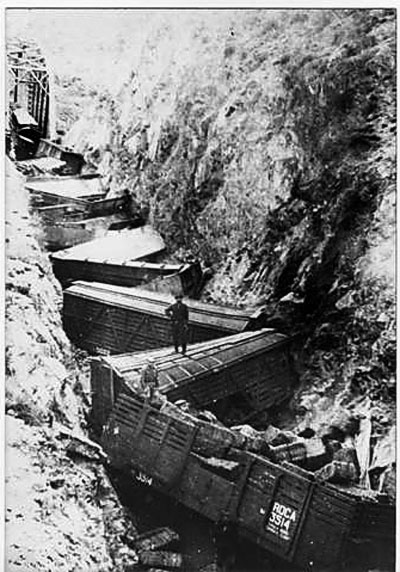
Closure and re-opening
From 1990 onwards there were repeated threats and notices of complete closure. Somehow it never quite happened but the FFCC Argentinos were being broken up anyway and in May 1992 the assets were divided between the two provincial governments of Río Negro and Chubut. A weekly passenger train continued to run until December 1993 when, the main road having been tarred at last, closure was again announced.
The Chubut administration were already well aware of the line's potential to attract tourists, and in the following February, 1994, the province took on responsibility for running a weekly passenger service on the southern half of the line, from El Maitén to Esquel. Since then operations have continued in Chubut province, with attempts to promote the tourist market, and some repainting of engines etc. Whilst Río Negro ran a service from 1994 to 1996 there have been no timetabled trains on the northern section since that time. Keith Taylorson's book on the line (2) covers this recent period of the line's history in a good deal more detail.
Whilst the railway has been declared a National Historic Landmark, there is very little money around to do anything more than the minimum. The line is now running with perhaps twenty-five staff, compared to the three hundred or so of earlier days.
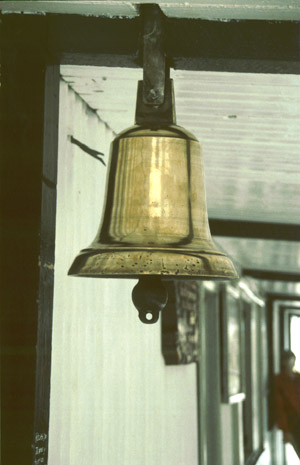 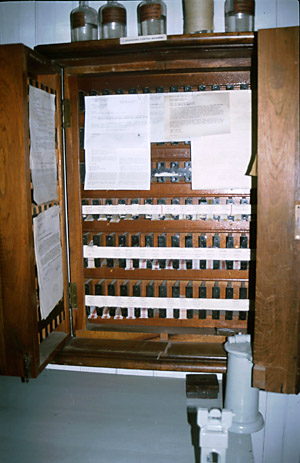
The station bell and ticket rack at Esquel. The former is now kept safe and only brought out on operating days. One can't help wondering whether is it a rare survivor of the 25 bells which once adorned the Baldwin locos.
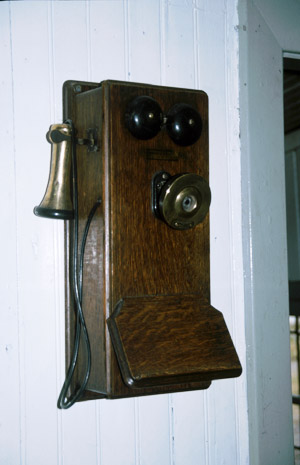
The telephone in the old station building at Esquel.
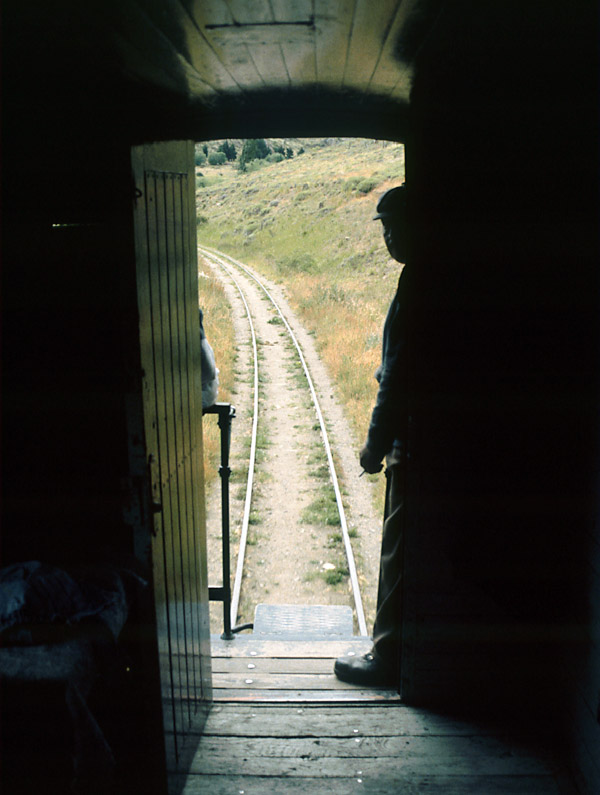
A view from the furgon at the rear of a train climbing out of Esquel.
References
1 El Viejo Expreso Patagónico (a bilingual guide book), Rodolfo Rena, Producciones Publicitarias Puppy, 1998 4th edition.
2 Narrow Gauge Rails to Esquel, Keith Taylorson, 1999, 23 Hanover St., Brighton, BN2 2ST, UK.
3 Historia de los Ferrocarriles Argentinos. 1947. Ferrocarriles del Estado, Buenos Aires.
4 Baldwin Locomotives magazine, October 1922.
5 Estadistica de Ferrocarriles en Explotación, 1940-1.
30-7-09
|

